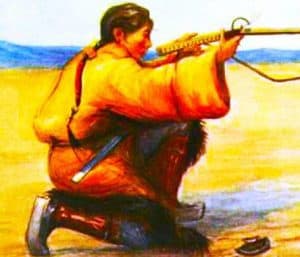
Using Fairy Tales
To Debate Ethics
By Elaine L. Lindy
What better way to spark a spirited classroom debate on ethics than by exploring the complex messages often found in fairy tales? In this Education World story, guest editor Elaine L. Lindy introduces three tales -- Puss in Boots, Jack and the Beanstalk, and a Tibetan tale, From the Elephant Pit -- that can be used for starters! Included: Tips for managing an ethics debate in the elementary or middle school classroom!
What better way to spark a spirited classroom debate on ethics than by exploring the complex messages often found in fairy tales?
Children enjoy a cozy familiarity with fairy tales. By basing a discussion of ethics on fairy tales, you are launching from common ground. Children aged eight and older typically are ready for meatier ethical concepts, concepts that skirt into gray areas of lesser evils or relative priorities.
Following are a few suggestions drawn from the land of fairy tales to get your students' thought wheels humming.
PUSS IN BOOTS: WHEN IS TRICKERY JUSTIFIED?
In this classic French fairy tale, a clever cat engineers a succession of hoaxes and lies for the benefit of his master. As a result, his master eventually marries the king's daughter and appoints Puss in Boots prime minister, and all parties live happily ever after.
You can print a text version of Puss in Boots from the Internet. A well-illustrated version of the story is also available in The Golden Book of Fairy Tales, by Marie Ponsot (Golden Books).
|
Here, you might ask young readers, "Was Puss in Boots wrong to lie to the king and to deceive him?" The absolute quality of honesty can be leveled against the compelling urges of loyalty and friendship.
After several clever tricks, Puss in Boots leads the king and his lovely young daughter to a castle belonging to an ogre. Running ahead of the group, the frisky feline dares the ogre to transform himself into a mouse. When the ogre successfully transforms himself, Puss in Boots promptly pounces on the hapless creature and devours him. That enables his young master, who arrives moments later with the king and his entourage, to claim that the castle is his own. In so doing, the young man clinches his nuptial prospects with the king's daughter.
Here, you can further challenge your students: "Was the cat wrong to trick the ogre and then kill him?" Youngsters who argued earlier that the king was in no way damaged by the verbal deceptions and exaggerations of Puss in Boots must reckon with an act leading to an untimely death.Finally, pose this question: "Is trickery ever justified?" Challenge students to support their positions, whatever they may be, with at least three cogent arguments.
JACK AND THE BEANSTALK: IS TAKING A GOOSE AND A HARP FROM AN EVIL GIANT STEALING?
Your students might enjoy acting out a play version of Jack and the Beanstalk.
This classic story offers a twist on the theme of honesty. We all know the story of young Jack, whose impoverished mother is left with nothing but the family cow. Jack is sent to market to trade the cow for as much money as he can. Jack trades the cow for a handful of beans, and in despair, his mother throws the beans out the window.
Overnight, a giant beanstalk grows into the sky. When Jack climbs to the top of the beanstalk, he finds the home of a mean giant. Narrowly escaping from the giant with his life, Jack scampers down the beanstalk with two treasures stolen from the giant -- a goose that lays golden eggs, and a magic harp. Thus, Jack happily secures the future for himself and his mother.
You might begin by reiterating that Jack faced imminent danger in the giant's house ("Fee! Fi! Fo! Fum! I smell the blood of an Englishman!"). Ask: "Since the giant wanted to eat Jack, was it OK that Jack stole the giant's goose and harp?"
Listen carefully to the arguments raised, pro and con. You might follow up with this remark: "Remember that Jack was an intruder in the giant's house. Since Jack chose to enter the giant's house, does that change your opinion?"
This exercise is also recommended: "Pretend you are the giant. Describe what happens when Jack arrives in your house and how you feel about it."
In a 19th-century version of Jack and the Beanstalk, a fairy is introduced when Jack is climbing up the beanstalk. The fairy informs Jack that Jack's father was a wealthy and prosperous landowner but that a mean giant killed the father, stole everything his father owned, and reduced Jack's mother and her infant son to poverty. That giant, according to the fairy, is the one who lives at the top of the beanstalk, and by destroying the giant, Jack will restore his family wealth.
This version of the fairy tale opens another line of questioning: "Since the giant had stolen everything from Jack's father, do you think it was OK for Jack to take it back?" Most youngsters will heartily agree.Follow up with this question: "What if it had been the giant's father who had stolen everything from Jack's father; would it still be OK for Jack to take the treasures?" Then ask: "What if it had been the giant's grandfather who had stolen everything from Jack's grandfather?" And then ask: "What if it had been 100 years before that the giant's ancestor had stolen everything? Do you think it would still be OK for Jack to take the treasures?" Try to find the amount of elapsed time necessary, according to students, to justify Jack's taking the treasures. Then challenge them to defend their point of view.
FROM THE ELEPHANT PIT: IS COMPASSION PRACTICAL?
A lesser-known Tibetan folktale From the Elephant Pit is about a hunter who happens upon an elephant pit in which a man, a lion, a mouse, a snake, and a falcon are trapped.
The lion warns the hunter not to rescue the human, saying, "I and the other animals will prove grateful to you and will help you for your kindness to us, so rescue them. But please leave the man in the pit, for I warn you, he will forget your kindness and do you harm." However, the hunter rescues all the animals and the man.
The other animals indeed later repay the kindness to the hunter, and as the lion foretold, the man betrays him. Still, by the end of the story, the betrayal of the man is revealed, the hunter is appointed chief hunter to the king, and all ends well.
On the Absolutely Whootie Web site, children are asked this question:
"Do you think the hunter was better off because he rescued the man from the pit? If you think yes, why? If you think no, why not?"
Following is a sampling of responses from youngsters who responded at the Web site:
"Yes, you should always save someone in need."
-- Vance, age 10
"No, because if he would have left him he wouldn't have gone through all that trouble."
-- Tara, age 11
"No, because the man tricked the hunter and ruined his life."
-- Newt, age 9
"Yes, because he did something very kind, which is the best reward anyone could get."
-- Laura, age 10
"Yes, because he got to be the king's top man."
--Shawn, age 7
|
Article by Elaine L. Lindy
Education World®
Copyright © 2003 Education World
Education World®
Copyright © 2003 Education World
Elaine L. Lindy is an expert on storytelling for character education. As CEO of Whootie Owl Productions, LLC, a Massachusetts-based company, she created Absolutely Whootie: Stories to Grow By, a Web site that features dozens of fairy tales and folktales from around the world. Each tale is upbeat, kid-tested, nondenominational, copyright available, amply footnoted, and free! The Web site has been recognized by USA Today, Highlights for Children,Teachers.net, and many others.









